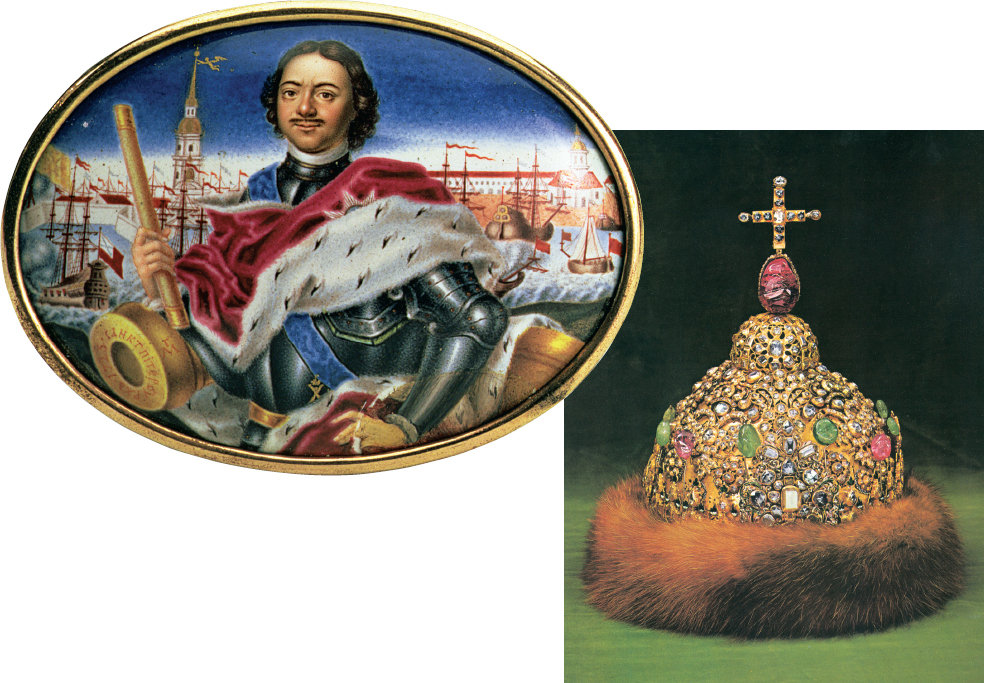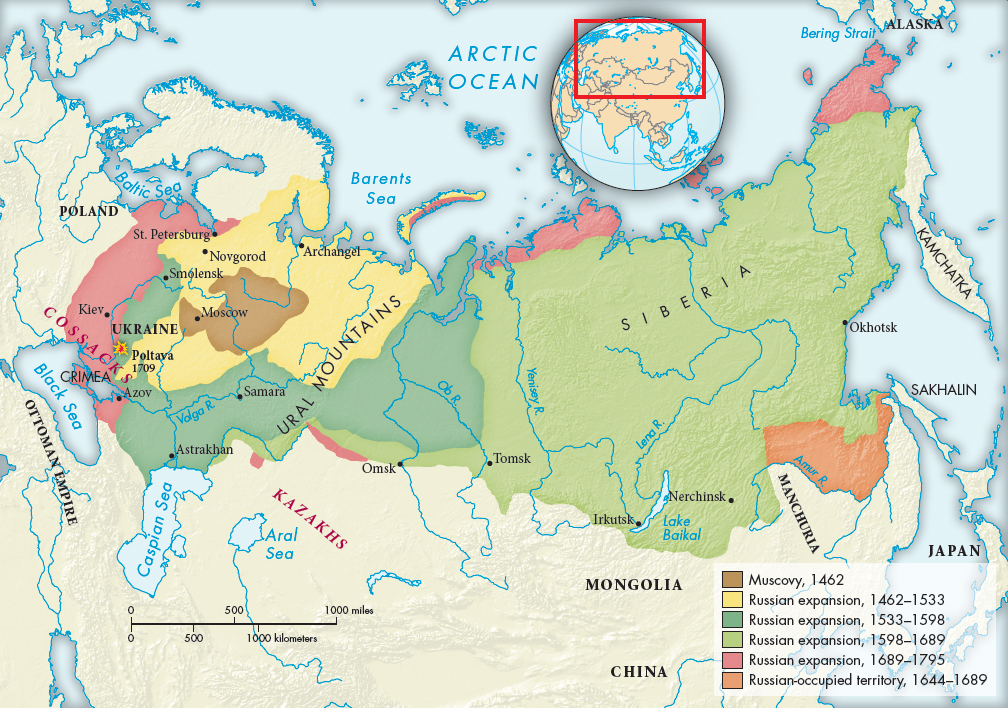Understanding World Societies:
Printed Page 541
Chapter Chronology
Peter the Great and Russia’s Turn to the West
Heir to his predecessors’ efforts at state-building, Peter the Great (r. 1682–1725) embarked on a tremendous campaign to accelerate and complete these processes. Peter built on the service obligations of Ivan the Terrible and his successors and continued their tradition of territorial expansion. Peter’s ambitions hinged on gaining access to the sea by extending Russia’s borders to the Black Sea (controlled by the Ottomans) and to the Baltic Sea (dominated by Sweden).
Peter embarked on his first territorial goal by conquering the Ottoman fort of Azov in 1696 and quickly built Russia’s first navy base nearby. In 1697 the tsar went on an eighteen-month tour of western European capitals. Peter was fascinated by foreign technology, and he hoped to forge an anti-Ottoman alliance to strengthen his hold on the Black Sea. Peter failed to secure a military alliance, but he did learn his lessons from the growing power of the Dutch and the English.
To realize his second goal, Peter entered the Great Northern War (1700–1721) against Sweden. After a humiliating defeat at the Battle of Narva in 1700, Peter responded with measures designed to increase state power, strengthen his military, and gain victory. He required all nobles to serve in the army or in the civil administration — for life. Peter also created schools and universities to produce skilled technicians and experts. Furthermore, he established an interlocking military-civilian bureaucracy with fourteen ranks, and he decreed that all had to start at the bottom and work toward the top. He sought talented foreigners and placed them in his service. These measures gradually combined to make the army and government more powerful and efficient.

Peter the Great
This compelling portrait by Grigory Musikiysky captures the strength and determination of the warrior-tsar in 1723, after more than three decades of personal rule. In his hand Peter holds the scepter, symbol of royal sovereignty, and across his breastplate is draped an ermine fur, a mark of honor. In the background are the battleships of Russia’s new Baltic fleet and the famous St. Peter and St. Paul Fortress that Peter built in St. Petersburg. Peter the Great commissioned this magnificent new crown (left) for himself for his 1682 joint coronation with his half brother Ivan. (crown: bpk, Berlin/Kremlin Museum, Moscow, Russia/Art Resource, NY; portrait: Hermitage, St. Petersburg, Russia/The Bridgeman Art Library)
Peter also greatly increased the service requirements of commoners. He established a regular standing army of peasant-soldiers, drafted for life. In addition, he created special regiments of Cossacks and foreign mercenaries. To fund the army, taxes on peasants increased threefold during Peter’s reign. Serfs were also arbitrarily assigned to work in the growing number of factories and mines that supplied the military.
In 1709 Peter’s new war machine was able to crush Sweden’s army in Ukraine at Poltava (Map 18.5). Russia’s victory against Sweden was conclusive in 1721, and Estonia and present-day Latvia came under Russian rule for the first time. As a result, Russia became the dominant power in the Baltic and very much a great European power.

MAP 18.5The Expansion of Russia, 1462–1689In little more than two centuries, Russia expanded from the small principality of Muscovy to an enormous multiethnic empire, stretching from the borders of western Europe through northern Asia to the Pacific.
After his victory at Poltava, Peter channeled enormous resources into building a new Western-style capital on the Baltic. The city of St. Petersburg was designed to reflect modern urban planning with wide, straight avenues; buildings set in a uniform line; and large parks. Each summer, twenty-five thousand to forty thousand peasants were sent to provide construction labor in St. Petersburg without pay.
There were other important consequences of Peter’s reign. For Peter, modernization meant westernization, and both Westerners and Western ideas flowed into Russia for the first time. He required nobles to shave their heavy beards and wear Western clothing. He also required them to attend parties where young men and women would mix together and freely choose their own spouses. From these efforts a new elite class of Western-oriented Russians began to emerge.
Peter’s reforms were unpopular with many Russians. For nobles, one of Peter’s most detested reforms was the imposition of unigeniture — inheritance of land by one son alone. For peasants, the reign of the tsar saw a significant increase in the bonds of serfdom. Nonetheless, Peter’s modernizing and westernizing of Russia paved the way for it to move somewhat closer to the European mainstream in its thought and institutions during the Enlightenment, especially under Catherine the Great (see “Enlightened Absolutism and Its Limits” in Chapter 19).
What were Peter the Great’s primary goals? How did he go about achieving them?

